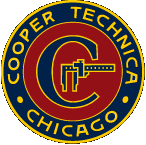

Article at "Old Cars Weekly"
An Alfa Romeo mystery
July 21, 2010by Sharon Thatcher, Old Cars Weekly
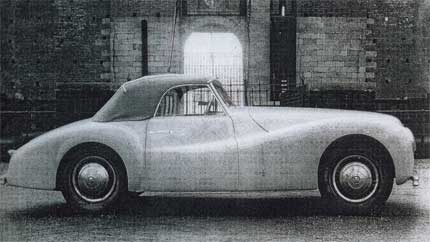
This Alfa Romeo 6C2500 was custom built for Wolfram Von Richthofen by Carozzeria Pinin Farina in Milan, Italy.
A rare Alfa Romeo 6C2500 Super Sport model that arrived in the United States in parts is getting its life back together again. And what an unusual life it has been.
First commissioned into existence by a German officer at the hands of a master coachbuilder, it had a second life as a race car in Italy before its history was nearly forgotten.
Today, its past has been unraveled in an intriguing worldwide search, and the task of rebuilding the car to its former glory is well under way.
Taking the long and winding path back to its beginnings, however, the search was on to find a great car in need of restoration. Hired for the project was David Cooper of Cooper Technica in Chicago, Ill. Cooper brought the buyer and seller of the car together. "At my client's request, I put the word out that I was looking for an interesting car to restore," Cooper said. "A broker friend in California suggested several cars and this one was chosen."
What made the car stand out was its extraordinary design, along with its connection to well-known German military officer Wolfram Von Richthofen. He was a cousin of the famous, 'Red Baron', World War I fighter pilot ace Manfred Von Richthofen, but Wolfgram had his own illustrious military career. He served in Italy first in the late 1920s and again in 1941-'42 as a commander of the 2nd German Air Force of Italy. In 1943, he served in the campaign against the Soviet Union, where he was promoted to Field Marshal, the youngest man ever given the rank.
Von Richthofen apparently enjoyed fine automobiles and ordered the Alfa Romeo in 1942. He received it at the end of 1943.
"We knew the Von Richthofen connection from a register of all the 6C2500 cars published in the book, Alfa Romeo 6C2500 by Tito Anselmi. This was the first clue that enabled us to track down the history of this car," Cooper says.
Unlike most Alfa Romeos built at the Alfa Romeo plant, each of the 6C2500 models was custom built. "Alfa Romeo manufactured their own sedan bodies, but for the Super Sports models they would supply the engine, the chassis and the drivetrain and then have coachbuilders make a custom body on that platform," Cooper said. The Von Richthofen car started as a steel structure wrapped in aluminum at a time when such cars generally had wood structures. "That was very innovative at that time," Cooper noted.
The car was built by Carozzeria Pinin Farina, "the company founded by famed coachbuilder and designer Battista "Pinin" Farina, in Milan. True to his nature, Farina offered a car with a unique and innovative design, combining the sweeping fender lines of the 1930's with the clean and smooth European body shapes that would become characteristic of 1940s and '50s design.
"Some of the most interesting [Alfa Romeos] are the small groups made during the war," Cooper said. Only 28 were made during the years of World War II, and only 14 are known to survive. In fact, Cooper is also directing the restoration of a second car. The Von Richthofen car was one of just six built for German officers, with only two still known to exist.
Von Richthofen had the car only a short time. He developed a brain tumor in the summer of 1942 and was hospitalized, then died in spring 1945, just as the war was ending.
The car subsequently made its way to a new owner, who raced it in the Mille Miglia (1,000 miles) open road endurance race in Italy, from Rome to Brescia and back, finishing third in its class.
On that history alone, barring condition, the car was worth pursuing. Cooper, who has built a career out of finding, researching and orchestrating the restoration of very unique cars, particularly prewar and early postwar European sports and touring cars, was soon on his way to a restoration shop in New Zealand. He found the car disassembled and its owner looking to sell.
Cooper was instructed by his client to inspect the car and verify its provenance before negotiating a purchase, and he found the car had seen a lot of wear and tear over the years. It showed signs of body damage, red paint covered its original dove grey and somewhere along the line it had been given a new nose job. The car was restorable, however, and all the original pieces except the grille were still present. Before long, the deal was sealed and the car was shipped from Christchurch, New Zealand, to Cooper's restoration shop in Chicago.
Sleuthing for more history
Before any screw was torqued or any metal reshaped, the search was on to learn more about the car's true identity. "We spent a lot of time looking at the car, figuring out what we wanted to do before we did anything," Cooper said. "As with any car, without knowing what it was, it is difficult to know what it should be."
The Alfa Romeo mystery led Cooper to England, where he consulted with Alfa Romeo historians Angela Cherrett, Peter Marshall and Simon Moore, and to Italy, where he was helped by the author of the 6C2500 book, Anselmi. Recently, Cooper has been corresponding with Von Richthofen's biographer about the car.
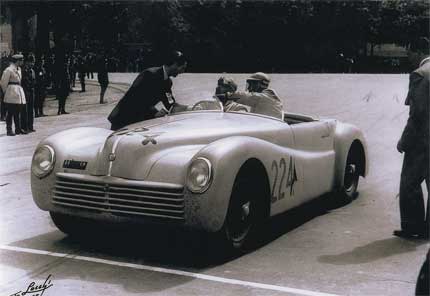
The car’s second owner, Spartaco Graziani, raced it in the 1948
Mille Miglia race.
"I contacted Anselmi to find out if he knew more about this car," Cooper said. "I had hired an Italian friend who worked as my interpreter. She visited Anselmi, a perfect gentleman, who suggested she contact a photo archive in Florence for photos of the car during the Mille Miglia. These photos revealed that the Alfa had raced in the 1948 Mille Miglia under the number 224."
Armed with these photos showing the car number, Cooper went to Brescia to obtain information from the Mille Miglia archives. They had the original race book and other documents, including a cancelled check from the car's second owner and 1948 Mille Miglia race driver Spartaco Graziani.
It's unclear what happened to the car immediately after Von Richthofen's death, but somehow the car made its way back to Alfa Romeo. Graziani was a friend of the chief test driver for Alfa Romeo," Cooper said. "It seems likely he heard about the car from him."
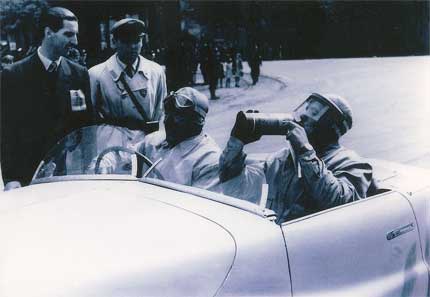
Graziani came in 22nd overall in the 1948 Mille Miglia and finished
the best of the three 6C2500 cars and third in a field of 25 cars in
the Over 2.0 Liter Class.
Although the 6C2500 was not designed as a race car, it did have the speed and guts to go the distance. "Graziani raced it at least three times," Cooper said. "In the Mille Miglia, he came in 22nd overall, and finished the best of the three 6C2500 cars at third in a field of 25 cars in the Over 2.0 Liter Class."
The history of the car was deepening, and so was the mystery.
A conversation with Graziani's son
Cooper needed to learn more. The cancelled check he received from the Brescia archives showed an address for Graziani in Livorno on the west coast of Italy. Cooper wondered if someone in the family still lived at the address.
"Sure enough his son was still there," Cooper said. "I talked to his son on the phone with my Italian friend acting as translator. Unfortunately, he said that he was only seven when his father had the car, and he didn't remember anything. His father owned a lot of cars.
"But then this thing happened that was so phenomenal," Cooper continued, his voice revealing the excitement he still feels over that moment in his pursuit. "He asked me what color was the car, and I told him, dove grey. Then he asked, 'Was this car painted red after that?' And he said, 'Wait a minute. I remember the car.' His father had the car painted red in Milan. Then he started remembering other things. I asked him if he had any pictures or documents. He said all he had was the diploma. And I asked him, 'What diploma?' Turns out, the diploma was the hand-lettered and hand-colored certificate his father received for the Mille Miglia race."
The son not only had the diploma, but he offered to sell it to Cooper. "It was stored in a bad frame and had light and acid damage," Cooper said. "I had the document restored at a firm who does work for the Art Institute of Chicago. Now it's stored in an archival frame."
From the son, Cooper also learned that the car had been in an accident some time after the Mille Miglia race. "The grille was destroyed. Graziani sent it to a body shop he knew in Milan in about '53 or '54, and they installed a different grille, from an Alfa Romeo model 1900. The son told me that Graziani had it painted red after the accident so he could sell it more easily."
Graziani's son, who thought he recalled nothing, had provided Cooper with some of the most valuable details yet about the history of Von Richthofen's 6C2500.
The rest of the history
Eventually, Cooper was able to put even more of the pieces together, determining every owner of the car from beginning to present. Graziani had it from 1946 to about 1954, then it was sold to a friend, an American officer, stationed at the American Air Force base in Livorno. "The U.S. had a deal where officers could ship cars back to the States at no charge or minimal charge, so a lot of cars were shipped to the United States from Europe during that time," Cooper said.
This car was sent to New York, where it remained for a year or two before the owner sold it to a friend of his in California. There, the well-traveled car found its most permanent home from 1956 until 2000. "Sometime in the 1960s, I believe, it had some engine problems and they took the engine out to rebuild," Cooper said. "The story is that the crankshaft fell off a shelf during an earthquake and broke in half. I now have this broken crankshaft, along with a new one that was fabricated. When the owner died, the family sold the car. It went to a Chinese man from Hong Kong. He had the car shipped to Australia for restoration."
At the Australian shop, the restoration was halted and the owner decided to sell the car in its partially restored condition. For tax reasons, the car was shipped to New Zealand to wait for a buyer. Cooper's client was one of several potential buyers, and eventually became the new owner of this diamond in the rough.
The restoration begins
Now supplied with the car's history, the owner could decide how to proceed with the restoration. "Our specialty is to maximize the value of the car through research and careful restoration, to bring a car back to its most valuable state, which is generally the original," Cooper explained. The owner of the car decided to return the car to way it looked when it first rolled out of Pinin Farina's shop in 1943.
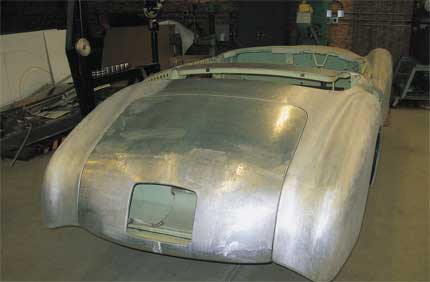
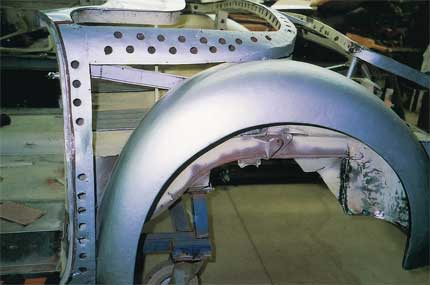
Mike Pavletic of Pavletic Metal Shaping in Zion, Ill., was chosen
to restore the Alfa Romeo’s body because he is one of the few
restorers who has mastered original techniques and methods.
Cooper's Chicago shop would oversee the restoration, do the engine, mechanical and electrical work and re-assemble the Alfa Romeo 6C2500, but the bodywork needed the hands of a master metalworker. Cooper approached Mike Pavletic of Pavletic Metal Shaping, in Zion, Ill. "Mike is incredibly talented," Cooper said. "He is a master of all the original techniques and methods that were used when the body was first fabricated."
Pavletic has been in business for 37 years after working for other shops and says he was becoming frustrated by people who "just wanted to make a quick buck and do the work the fastest way possible." He knew that prize-winning cars needed time and precision. "This is something that takes many, many years to learn. It takes a lifelong passion to do this," he said.
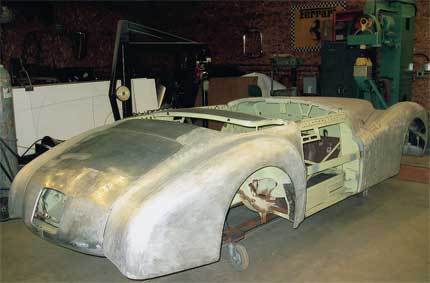
His two sons, Chase and Ryan, were raised in the business and together they have a lot of experience working on high-end European cars that have gone on to garner awards, including working with Cooper on another custom-built Alfa Romeo 6C2500.
But Pavletic is a down-to-earth, no nonsense kind of guy who enjoys any challenge, regardless of lineage, and is a stickler for doing things right. “To me it doesn’t matter what cars I’m working on, it’s nice to work on different types,” he said. He does, however, like variety, which explains why he also enjoys an occasional hot rod. “When you’re doing restoration, you’re boxed into doing it one way, the way it was when it was built,” he explained. “But with hot rods, you have the freedom to do just about anything. That’s why we enjoy doing both.”
The 6C2500 offered a special challenge: a beauty that needed to be lifted out of an aging shell. “It was in poor shape," Pavletic said of the car when he first received it. In the accident, the car's horizontal grille was apparently busted and a later model, oval grille had been put in its place. “It was kind of like a hidden car," Pavletic said. Somewhere, the original car was still lurking underneath.
“With Alfa Romeos, they start with a typical steel frame — steel door frames, steel deck frame and steel structure — and the aluminum is essentially wrapped around the steel frame, not welded, but wrapped,” Pavletic said. Under racing conditions, the aluminum can get fatigued, crack and fall apart. In this case, however, some of the body panels had been ground thin in a previous repair or restoration attempt. “Once you’ve ground it too thin, you can’t make it thicker,” Pavletic said. Parts original to the car were used to make new pieces, and so far little has gone to waste.
In phase one of the restoration, Pavletic worked on the rear quarter panels and the deck lid, door frames, door seals, battery boxes and the rear wheel wells. The car was then returned to Cooper Technica for fitting of the mechanical parts, restoration of the doors and latches and the engine rebuild.
For the next phase of the restoration, Pavletic will finish the front end, returning it to its original appearance with a horizontal-style grille. It will then be painted its original dove grey color.
Today, the car is about 60 percent of the way back to its former glory. As is often the case with such complex projects, there is no exact time line for when it will be completed. “In an ideal situation, if a person could go forward with a restoration, a shop could do it in a year or two. But it all depends on the owner. Sometimes it can take years,” Pavletic said.
One thing is for sure: when it is finished, what a grand finish it will be.
>>Back to Current Projects Main Page
Home | About | Current Projects | Past Projects | Contact | Other Work | Bicycles | For Sale
© 2000 -
2025 Cooper Technica, Inc. - Chicago. All rights reserved.
Restoration of Vintage Automobiles
Privacy Policy
Restoration of Vintage Automobiles
